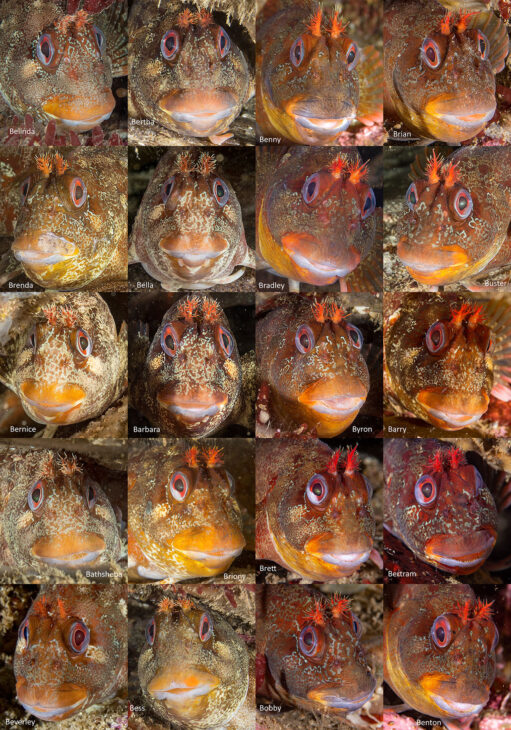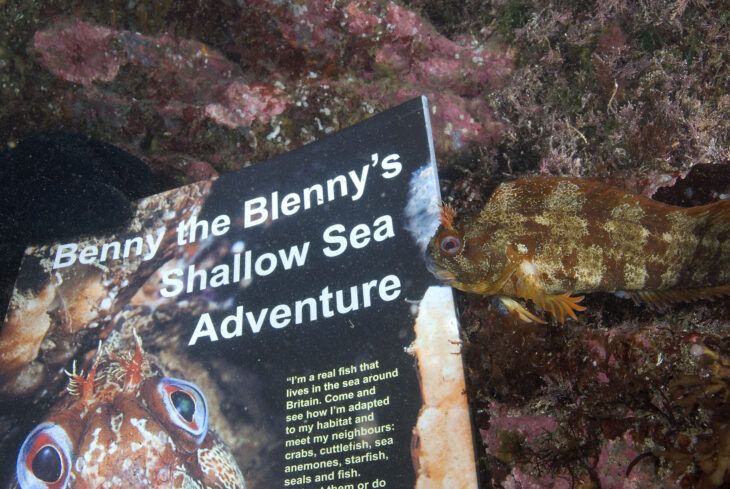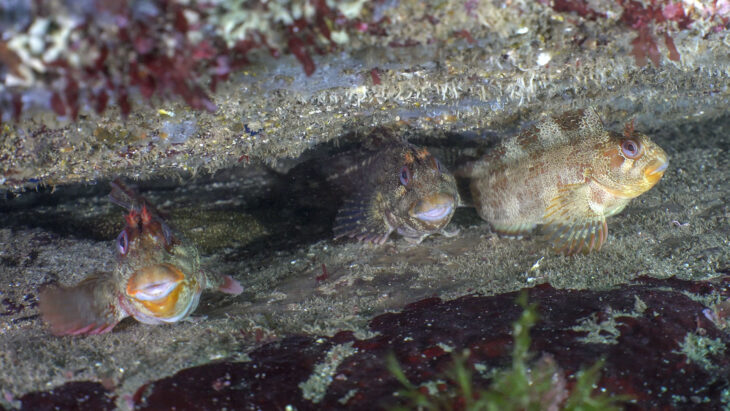Written by NBN Trust CEO, Lisa Chilton
This month’s dose of ‘Nature Positive’ is a window into the intriguing sex life of one of our most endearing coastal fish – the tompot blenny – and the passion that led marine biologist and underwater photographer, Paul Naylor, to dedicate 11 years to this meticulous, self-funded study.

The tompot blenny is a firm favourite amongst divers and snorkellers around UK coasts. Small but feisty, this colourful fish with its frilly red antlers (officially known as ‘head tentacles’) often interacts with human visitors to its rocky domain. The species is regularly recorded by Seasearch volunteers and there are more than 4,500 records on the NBN Atlas, stretching from Shetland to Scilly.
Diving and snorkelling on his local patch in South Devon, Paul got to know two reefs boasting a series of horizontal crevices that were the territory of male tompots. In the breeding season, males lay claim to a resident crevice which they energetically defend. Female tompots visit the crevices to lay their eggs, which the male fertilises and guards until they hatch.
What led Paul from casual observation to near-obsession was the realisation that individual blennies could be reliably recognised from their facial markings. Photo-identification is long established as a technique for studying whales and dolphins, but this was a game-changer for the tompot blenny, presenting the possibility of gaining detailed insights into the behaviour of this characterful little fish.
An incredible 562 dives later, Paul had assembled a catalogue of more than 50 recognised blennies. In a great-looking line-up that any dating app would be proud of (Plenty of Fish springs to mind; other dating apps are available), there’s Bernice, Bradley, Byron, Brenda, Bertram, Buster, Belinda and Blanche (you’ll see a theme emerging!), and not forgetting Benny, the tompot ‘poster boy’, who has his own book and blog written by Teresa Naylor.

Paul says “My favourite observations come from watching tompot pecking orders in action. A medium-sized blenny bullies a small one but, as soon it gets the upper hand (fin?), a larger one appears to put that one in its place; and it often gets more convoluted than that!”
“Velvet swimming crabs are renowned for being fierce but just wait until you see one get near a tompot blenny, especially if it’s a male guarding eggs. There’s only one winner, and it’s not the crab! One amazing experience was taking a copy of Teresa’s Benny the Blenny book down to show the real Benny and him coming out to inspect it!”

But what of the promised bed-hopping antics? Paul’s study confirmed that both male and female blennies are promiscuous, with females laying batches of eggs in multiple males’ territories. The size of those batches seems to vary with the males’ status, however, so the females are still being choosy, and this is what makes blennies’ social lives so fascinatingly complicated. Suitable crevices are in short supply and younger, smaller males may not be able to hold them. This doesn’t necessarily preclude them from fatherhood however, as an alternative strategy is to sneak into another male’s resident crevice while a female is laying eggs and surreptitiously fertilise a few. Paul observed this behaviour on a few occasions, having been tipped off by seeing Billy (assumed, at that point, to be female), in the crevice of a territory-holding male in 2016. The following year, Billy showed his true colours and was guarding his own crevice territory. The value of recognising individual animals came to the fore in showing that all three ‘sneaker’ males observed by Paul became ‘respectable’ bourgeois males (the correct term!) later in life.

Paul’s work has revealed many more fascinating insights into the lives and loves of tompot blennies, and you can read about them on his website, where there are also great photos and videos, as well in a newly published paper in the Journal of Fish Biology (available from Paul on request). Paul’s wonderful book Great British Marine Animals, now in its 4th edition, also has an extended section on blenny behaviour. Paul and Teresa see these charming fish as ambassadors for UK seas. As Paul puts it, “Studies on behaviour, especially of individual animals, help people engage with our marine environment and appreciate its intricacy and vulnerability.”
Several of the NBN Trust’s member organisations provide opportunities to find out more about UK marine wildlife and take part in surveys to shed light on their ecology. A few examples include National Marine Week, Seasearch, the Big Seaweed Search, the Great Eggcase Hunt, and activities run by the Porcupine Marine Natural History Society.
